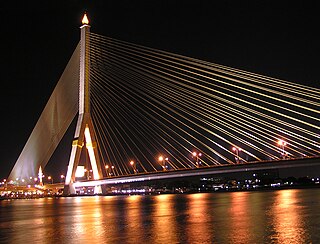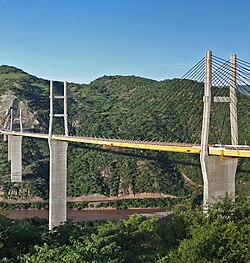
A cable-stayed bridge has one or more towers, from which cables support the bridge deck. A distinctive feature are the cables or stays, which run directly from the tower to the deck, normally forming a fan-like pattern or a series of parallel lines. This is in contrast to the modern suspension bridge, where the cables supporting the deck are suspended vertically from the main cable, anchored at both ends of the bridge and running between the towers. The cable-stayed bridge is optimal for spans longer than cantilever bridges and shorter than suspension bridges. This is the range within which cantilever bridges would rapidly grow heavier, and suspension bridge cabling would be more costly.

The Millau Viaduct is a multispan cable-stayed bridge completed in 2004 across the gorge valley of the Tarn near Millau in the Aveyron department in the Occitanie Region, in Southern France. The design team was led by engineer Michel Virlogeux and English architect Norman Foster. As of September 2020, it is the tallest bridge in the world, having a structural height of 336.4 metres (1,104 ft).

The Veterans' Glass City Skyway, commonly called the Toledo Skyway Bridge, is a cable-stayed bridge on Interstate 280 in Toledo, Ohio. After many delays, it opened in 2007. The bridge has taken traffic and reduced delays on the Robert Craig Memorial Bridge, a bascule bridge that was, until its transfer to local control, one of the last moveable bridges on the Interstate highway system. The Skyway is Ohio Department of Transportation's (ODOT) biggest single construction project.

The Tampico Bridge is a vehicular cable-stayed bridge connecting the Mexican states of Tamaulipas and Veracruz in eastern Mexico.

The Nordhordland Bridge is a combined cable-stayed and pontoon bridge which crosses Salhusfjorden between Klauvaneset and the island of Flatøy in Vestland county, Norway. It is 1,614 meters (5,295 ft) long, of which the pontoon section is 1,246 meters (4,088 ft) long. The cable-stayed section consists of a single 99-meter (325 ft) tall H-pylon which has a length of 368 meters (1,207 ft) and a main span of 172 meters (564 ft). This allows for a clearance of 32 meters (105 ft).

An extradosed bridge employs a structure that combines the main elements of both a prestressed box girder bridge and a cable-stayed bridge. The name comes from the word extrados, the exterior or upper curve of an arch, and refers to how the "stay cables" on an extradosed bridge are not considered as such in the design, but are instead treated as external prestressing tendons deviating upward from the deck. In this concept, they remain part of the main bridge superstructure.

The Bandra–Worli Sea Link is a 5.6 km long, 8-lane wide bridge that links Bandra in the Western Suburbs of Mumbai with Worli in South Mumbai. It is the 4th longest bridge in India after Bhupen Hazarika Setu, Dibang River Bridge and Mahatma Gandhi Setu. It is a cable-stayed bridge with pre-stressed concrete-steel viaducts on either side. It was planned as a part of the proposed Western Freeway that would link the Western Suburbs to Nariman Point in Mumbai's main business district, but is now planned to become part of the Coastal Road to Kandivali.

Erasmusbrug is a combined cable-stayed and bascule bridge, construction began in 1986 and was completed in 1996. It crosses the Nieuwe Maas in the centre of Rotterdam, connecting the north and south parts of this city, second largest in the Netherlands. The bridge was named in 1992 after Desiderius Erasmus, a prominent Christian Renaissance humanist also known as Erasmus of Rotterdam. The Erasmus Bridge is Rotterdam's most important landmark and is even part of the city's official logo.

Perai River Bridge is a dual-three lane cable stayed bridge connecting the banks of the Perai River in Perai, Penang, Malaysia. It is part of the Butterworth Outer Ring Road (BORR).

The Rama VIII Bridge is a cable-stayed bridge crossing the Chao Phraya River in Bangkok, Thailand. It was built to alleviate traffic congestion on the nearby Phra Pinklao Bridge. Construction of the bridge took place from 1999 to 2002. The bridge was opened on 7 May 2002 and inaugurated on 20 September, the birth anniversary of the late King Ananda Mahidol, after whom it is named. The bridge has an asymmetrical design, with a single pylon in an inverted Y shape on the west bank of the river. Its eighty-four cables are arranged in pairs on the side of the main span and in a single row on the other. The bridge has a main span of 300 metres (980 ft), and was one of the world's largest asymmetrical cable-stayed bridges at the time of its completion.
Federal Highway 95 connects Mexico City to Acapulco, Guerrero. The Autopista del Sol is a tolled alternative, which bypasses several towns of the state of Guerrero, including the city Iguala, and thus reduces transit time between Acapulco from Mexico city from 8 hours to almost 3.5 hours.

The Jinan Yellow River Bridge, also known as the Jinan Yellow River Highway Bridge, is a cable-stayed road bridge across the Yellow River in the city of Jinan, Shandong Province, China.

The Baluarte Bridge, officially the Baluarte Bicentennial Bridge, is a cable-stayed bridge in Mexico. It is located between the municipalities of Concordia in Sinaloa and Pueblo Nuevo in Durango, along the Durango–Mazatlán highway, Mexico 40D. The bridge has a total length of 1,124 m (3,688 ft), with a central cable-stayed span of 520 m (1,710 ft). With the road deck at 403 m (1,322 ft) above the valley below, the Baluarte Bridge is the third-highest cable-stayed bridge in the world, the seventh-highest bridge overall and the highest bridge in the Americas.

Cuetlajuchitlán is a Mesoamerican archaeological site located 3 kilometers southeast of Paso Morelos, in the northeast of the Mexican state of Guerrero.

Vidyasagar Setu, also known as the Second Hooghly Bridge, is a toll bridge over the Hooghly River in West Bengal, India, linking the cities of Kolkata and Howrah.

Smaalenene bridge, and the new part of the highway between Oslo and Stockholm was opened November 23, 2010 by the Norwegian Prime Minister Jens Stoltenberg. The bridge is 315 meters long and crosses the longest river in Norway, Glomma. The main span is 185 meters and the tower is 88 meter high. The buildingprosess was started in 2007.

The Indian River Inlet Bridge is a cable-stayed bridge located in Sussex County, Delaware, in the United States. It carries four lanes of Delaware Route 1 over the Indian River Inlet between the Indian River Bay and the Atlantic Ocean. The bridge also carries Delaware Bicycle Route 1 across the inlet. The bridge is within Delaware Seashore State Park between Dewey Beach and Bethany Beach. The Indian River Inlet Bridge is maintained by the Delaware Department of Transportation (DelDOT). The bridge is 2,600 feet (790 m) long and 107.66 feet (32.81 m) wide, with a span of 950 feet (290 m) and overhead clearance of 45 feet (14 m).

The Jiaxing-Shaoxing Sea Bridge, sometimes shortened to Jiashao Bridge, is the world's longest and widest multi-pylon cable-stayed bridge. From end to end, it stretches 10.14 km (6.3 mi) across the Qiantang River estuary, at Shaoxing, Zhejiang, China. The main bridge is 2,680 m (8,790 ft) long and 55.6 m (182 ft) wide and carries an expressway with eight traffic lanes. Construction started December 2008, and the toll bridge opened for traffic on July 20, 2013.
Federal Highway 95D is a toll highway connecting Mexico City to Acapulco, Guerrero. Highway 95D is among the most important toll roads in the country, serving as a backbone for traffic out of Mexico City toward Morelos and tourist destinations in Guerrero.

The Signature Bridge is a cantilever spar cable-stayed bridge which spans the Yamuna river at Tarun Goyat section, connecting Wazirabad to East Delhi. It is India's first asymmetrical cable-stayed bridge. The pylon of the Signature bridge is the tallest structure in Delhi and is double the height of Qutub Minar with its 154-metre high viewing box, which acts as selfie points for visitors. It shortens the travel time between north and northeast Delhi.




















